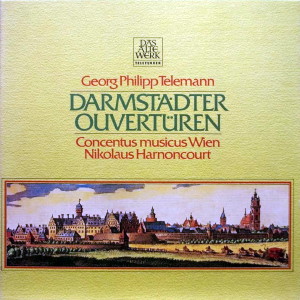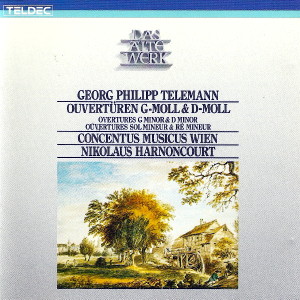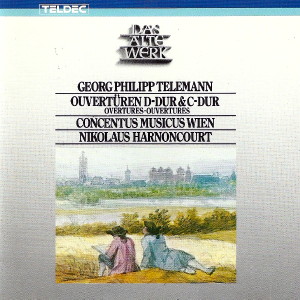 |
2 LP -
6.35498 EK - (p) 1980
|
 |
| 1 CD -
8.42986 ZK - (c) 1984 |
 |
| 1 CD -
8.42589 ZK - (c) 1985 |
|
| Antonio Vivaldi
(1678-1741) |
|
|
|
|
|
|
|
Darmstädter Ouvertüren
|
|
|
|
|
|
|
|
| Ouverture â 3 Hautbois; 2
Violins; Taille et Basse (D-dur),
TWV 55:D 15 |
|
22' 28" |
A |
| - Ouverture (Grave - Allegro
- Grave) |
6' 14" |
|
|
| - Prelude - très vite |
0' 45" |
|
|
| - Gigue |
2' 27" |
|
|
| - Menuet I/II,
alternativement |
3' 35" |
|
|
- Harlequinade
|
2' 08" |
|
|
- Loure
|
3' 29" |
|
|
| - Rondeau |
1' 27" |
|
|
- Rejouissance
|
2' 22" |
|
|
| Ouverture â 3 Hautbois; 2
Dessus pour Violons; 1 Taille; Bassoon
et Basse pour le Clavissin (g-moll),
TWV 55:g 4 |
|
19' 03" |
B |
- Ouverture (Grave - Allegro
- Grave)
|
7' 53"
|
|
|
| - Rondeau - Gayement |
1' 16" |
|
|
| - Les Irresoluts - à
discretion |
1' 43" |
|
|
- Les Capricieux
|
1' 20"
|
|
|
| - Loure |
2' 42" |
|
|
- Gasconnade
|
1' 48" |
|
|
- Menuet I/II,
alternativement
|
2' 20" |
|
|
| Ouverture â 8. 3 Hautbois; 2
Dessus pour les Violons; Taille; Bassoon
et Basse (d-moll), TWV 55:d 3 |
|
29' 30" |
C |
| - Ouverture (Grave - Allegro
- Grave) |
9' 51" |
|
|
| - Menuet I/II,
alternativement |
4' 05" |
|
|
| - Gavotte |
1' 38" |
|
|
| - Courante |
2' 02" |
|
|
| - Air |
1' 56" |
|
|
| - Loure |
2' 47" |
|
|
| - Hornepipe |
1' 45" |
|
|
| - Canaries |
1' 50" |
|
|
| - Gigue |
3' 36" |
|
|
| Ouverture â 7. 3 Hautbois; 2
Dessus pour les Violons; Taille et Basse
(C-dur), TWV 55:C 6 |
|
23' 56" |
D |
| - Ouverture (Grave - Allegro
- Grave) |
6' 04" |
|
|
| - Harlequinade |
2' 50" |
|
|
| - Espagniol |
2' 22" |
|
|
- Boureè en Trompette
|
1' 31" |
|
|
| - Sommeille |
2' 51" |
|
|
| - Rondeau |
1' 52" |
|
|
| - Menuet I/II,
alternativement |
3' 37" |
|
|
| - Gigue |
2' 49" |
|
|
|
|
|
|
CONCENTUS MUSICUS WIEN (mit
Originalinstrumenten)
|
|
| -
Jürg Schaeftlein, Oboe |
-
Wilhelm Mergl, Violine |
|
| -
David Reichenberg, Oboe |
-
Josef de Sordi, Violetta |
|
| -
Paul Hailperin, Oboe |
-
Kurt Theiner, Viola |
|
| -
Milan Turkovic, Fagott |
-
Nikolaus Harnoncourt, Violoncello |
|
| -
Alice Harnoncourt, Violine |
-
Eduard Hruza, Violone |
|
| -
Walter Pfeiffer, Violine |
-
Herbert Tachezi, Cembalo |
|
| -
Peter Schoberwalter, Violine |
-
Johann Sonnleitner, Organo |
|
| -
Anita Mitterer, Violine |
|
|
|
|
| Nikolaus Harnoncourt, Leitung |
|
|
Luogo
e data di registrazione
|
| Casino Zögernitz,
Vienna (Austria) - dicembre
1978 |
|
Registrazione
live / studio
|
| studio |
Producer
/ Engineer
|
Heinrich
Weritz
|
Prima Edizione CD
|
Teldec
"Das Alte Werk" - 8.42986 ZK - (1 cd) -
48' 33" - (c) 1984 - (Ouverturen TWV
55:g 4 e TWV 55:d 3)
Teldec "Das Alte Werk" - 8.42589
ZK - (1 cd) - 46'
24"
- (c) 1985 - (Ouverturen TWV
55:D 15 e TWV 55: C 6)
|
Prima
Edizione LP
|
Telefunken "Das
Alte Werk" - 6.35498 EK - (2
lp) - 41'
31"
+ 53' 26"
- (p) 1980
|
|
|
The Performance of the
Darmstadt overtures
|
The overtures (suites)
on this recording share one feature
that distinguishes them from
the conventional orchestral music of
their day: the scoring for woodwind.
As a rule there are two obbligato
oboes which play with the first
violins, occasionally one with the
first and one with the second violins,
thus achieving an enhancement
of tonal strength and colouring; there
is the occasional trio, the two oboes
playing little solos
with the bass. The bassoon usually has
no part specially written for
it, but simply plays the cello and
double bass line; it might have a solo
part when accompanying the oboe solos,
though this would not be apparent from
the score but was decided ad hoc by
the performer. In these pieces
Telemann uses a complete woodwind
quartet consisting of three oboes and
bassoon, thereby maintaining a particular
instrumental quality, thethird oboe
playing the viola part insofar as it
lies within its compass. This
combination of instruments enables
the woodwind to alternate with the
strings on an equal footing, since
both instrumental groups provide a
four-part texture. This possibility
produces a special style: the
dialogue is not now conducted within
unified sonorities by alternating
motifs and figures, but rather
between groups of basically
different timbre. With the attitudes
then prevailing towards polychoral
music, acoustics and sound
production. this is bound
to mean that the woodwind and
strings were physically separated,
possibly being provided with several
continuo instruments.
Some 20 or 30 years earlier
Georg Muffat made some interesting
comments and suggestions about the
execution of works of this type. He
left the distribution of the parts largely
to the performers themselves, and
described the performance with small
forces (omitting the inner parts)
and the execution with the largest possible orchestra
(which was particularly desirable)
in the following terms: “But it you
have a larger number of musicians at
your disposal you can not only
strengthen the first and second
violins of the big choir but also,
at your discretion, the two middle
violas and the bass; in addition,
the choir may be embellished by
accompanying it with harpsichords,
theorbos, harps and similar
instruments: the small choir. on the
other hand... which is how the word
‘concertino’ is always to be
understood, should only be played by
your three best fiddlers,
accompanied by an organ or a
theorbo... ”.
He added that these two “choirs”
could be placed physically apart
from one another; and indeed
individual continuo instruments
(organ or theorbo) only make sense
if this separation does take place.
This is how the Suite in D minor was
performed for this recording. In
this work the wind
group is most consistently set off
against the string group and the
dialogue is maintained from
beginning to end; even in the tutti
sections, in which the two choirs play
together, the wind
instruments are always written in
four parts, i.e. not concentrated on
the upper parts. On this recording
the two choirs are rigorously kept
apart; the continuo instrument for
the wind choir is an organ and for
the string choir
a harpsichord. Thus
the two groups are truly
self-contained.
In the Suite in D, as also in that
in C, the woodwind is contrasted
with the strings both in timbre and
in the concertante writing. It is
not, therefore, merely a question of
a dialogue between two groups of
equal importance (such a dialogue
does sometimes occur here, although
not as exclusively or as
consistently as in the Suite in D
minor), but also of an element of
concertante playing in which the
solo function of the woodwind is
emphasized from the outset by the
writing in a specifically
woodwind idiom. This was by
no means the rule in Telemann’s day:
at that time oboe parts were rarely
different from string parts. The
beginning of the Suite in C is characteristic in
stressing the unusual: the strings
are silent. The effect of hearing a
solo group start on its own instead
of the expected tutti must have been
quite staggering (Mozart describes a
similar surprise 50
years later at the first performance of
his “Paris” Symphony). In the two
suites on this record the woodwind writing
is always complete, in the same ways
as that for the strings; no parts
are ever doubled, but each
instrument has a part of its own.
The Suite in G minor is the one that
most closely follows the
conventions: in the tutti sections the
woodwind always plays with the upper
parts (the second as well as the
first oboe with the first violins,
the third oboe with the second
violins). The wind texture is in
four parts only in the solo
sections, or even in three parts,
the bass line being omitted from the
continuo.
For the present recording we have,
therefore, not only arranged the
rhythm and articulation of the
pieces according to the principles
appropriate to the tune at which they were
written, but have also related the
number and type of continuo
instrumets to the
texture of the individual works. We
have also experimented with their
placing for each piece separately,
and discovered
that in spite of the fact that the four suites are identically
scored, the optimum disposition is
by no means
always the same:
rather does each suite
require its own arrangement in accordance with the
orchestration peculiar to
it. We find exactly the same when
playing in public.
The practical consequence of this is
that a complete separation of the
choirs, with the two continuo
instruments placed at a distance
from one another, was required in
the Suite in D minor. The Suite in G
minor required the least separation,
and the Suites in C and D occupied
an intermediate position.
Nikolaus
Harnoncort
|
|
Nikolaus
Harnoncourt (1929-2016)
|

|

|
|